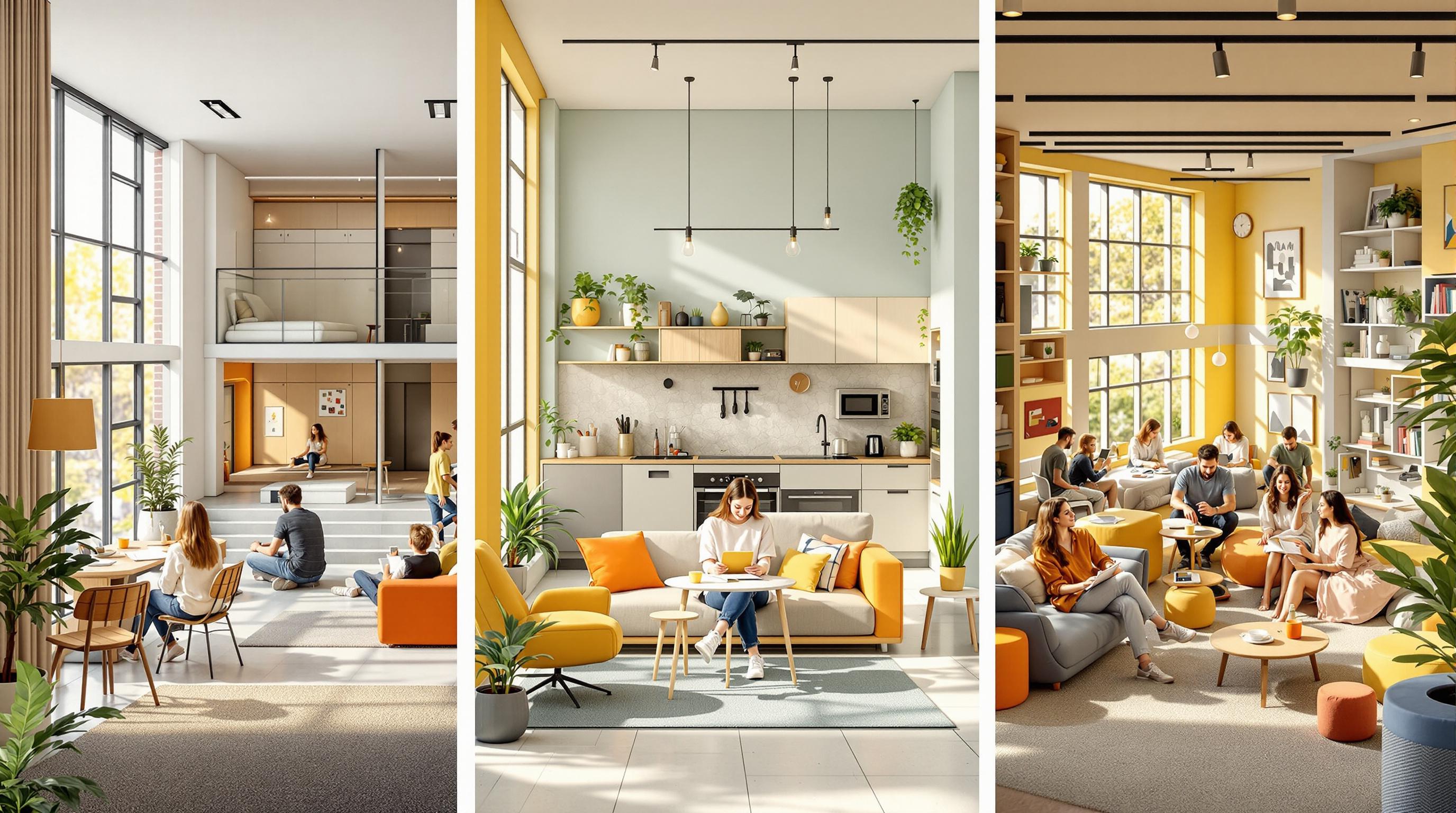Choosing the right student housing is crucial for your budget, lifestyle, and academic success. Here’s a quick breakdown of the three main options:
- Dorms: On-campus, structured living with utilities and internet included. Costs range from $333–$1,111/month. Great for first-year students and academic support.
- Private Apartments: Off-campus, independent living with more privacy. Rent is $600–$1,500/month (utilities and furniture often extra). Ideal for upperclassmen or those seeking more freedom.
- Coliving Spaces: Shared housing with private rooms and communal areas. Costs range from $400–$800/month, often all-inclusive (utilities, internet, furnishings). Balances community and independence.
Quick Comparison
| Housing Type | Monthly Cost | What's Included | Lease Terms | Social Opportunities |
|---|---|---|---|---|
| Dorms | $333–$1,111 | Utilities, Internet, Meal Plans | 9-month academic year | Built-in community |
| Private Apartments | $600–$1,500 | Basic unit (utilities extra) | 12-month leases | Less inherent social support |
| Coliving Spaces | $400–$800 | Utilities, Internet, Furnishings | Flexible options | Designed for social living |
Each option has its pros and cons, so consider your budget, location, and need for community or privacy when deciding.
1. Student Dorms
Student dorms are a cornerstone of college life, with 50% of U.S. college students opting for on-campus housing. At four-year institutions, the average cost for room and board is $12,111 per academic year, though this varies between public and private schools.
Public universities charge about $11,520 annually, while private schools average $13,028. Breaking it down monthly, that's $1,280 for public and $1,448 for private institutions. These costs generally cover a 9-month academic year, excluding summer and holiday breaks when dorms often close.
Living in a dorm isn't just about convenience - it can actually improve academic performance. Studies reveal that students living on-campus experience GPA increases between 0.19 and 0.97 points, which can mean nearly a full letter grade improvement. This is one reason many schools require freshmen to live in dorms.
| Cost Component | Public Universities | Private Universities |
|---|---|---|
| Annual Room & Board | $11,520 | $13,028 |
| Monthly Average | $1,280 | $1,448 |
| What's Included | Utilities, Internet, Meal Plan, Academic Support Services | Utilities, Internet, Meal Plan, Academic Support Services |
Dorm life offers a mix of social opportunities and academic support. As North Point highlights:
"Everyone needs privacy. At college, it helps you maintain your well-being and can be essential for achieving academic success, too. You need space to study in peace and time to examine your thoughts and feelings or just to unwind."
To make the most of dorm living, students can:
- Set specific times for quiet and studying
- Create personal space with tools like dividers or noise-canceling headphones
- Balance social activities with academic responsibilities
- Use on-campus tutoring and other resources
The convenience of dorm life is undeniable. Debt.org puts it this way:
"Paying for a dormitory involves paying for convenience. The student is on-campus, meeting new people, and learning the college culture."
Next, we’ll explore private apartments as an alternative housing option for students.
2. Private Apartments
Data from the Education Data Initiative shows that off-campus students at four-year public schools spend about $11,365 annually on room and board, while those at private institutions pay around $11,260. These costs vary widely based on location.
For example, the average monthly rent for a one-bedroom apartment is $3,780 in New York City but only $1,020 in Columbus. On top of rent, students need to budget for utilities, internet, furniture, and security deposits. Sharing an apartment can significantly lower these costs.
| Expense Category | Average Monthly Cost |
|---|---|
| Electricity & Heat | $175 |
| Internet | $50 |
| Basic Furniture (one-time) | $800–1,500 |
| Security Deposit | One month's rent |
Rent for solo apartments typically ranges from $800 to $2,000 per month. However, splitting costs with roommates can bring individual expenses down to $400–$1,200 per month, depending on the location and number of roommates. Keep in mind that while dorm contracts often last nine months, most apartment leases are for 12 months, which means students may need to plan for summer housing or find someone to sublet.
Proximity to campus plays a big role in both cost and convenience. Apartments closer to campus usually have higher rents but save on transportation costs. When choosing off-campus housing, students should consider walking distance to campus, access to grocery stores and public transportation, and neighborhood safety. A 2021 study highlighted location as a key factor in students' housing decisions.
Living in an apartment also comes with responsibilities like managing utility bills, handling maintenance, and staying on top of rent. These tasks not only offer more privacy and freedom but also help students develop skills they’ll use long after graduation.
3. Coliving Spaces
Coliving spaces provide a middle ground between private apartments and dorm living. These spaces combine the community vibe of dorms with the independence of apartments. Between 2015 and 2021, coliving expanded by nearly 40%, attracting €963 million in investment.
One of the biggest perks? All-inclusive pricing. Platforms like Coliving.com list options starting at $100 per month in over 350 cities. In Montreal, coliving spaces like Sonder cost between CAD 1,000 and 1,500 per month. When you factor in included amenities, these spaces often rival or even beat traditional student housing in affordability.
Coliving spaces typically balance private and shared areas. Take Tripalink's Post Chicago, for example. Fully furnished units start at $1,375 and include a mix of private and communal features:
| Amenity Type | Private Areas | Shared Spaces |
|---|---|---|
| Living Space | Bedroom, Bathroom | Kitchen, Lounge |
| Work Areas | Personal Desk | Coworking Spaces |
| Entertainment | In-room Smart TV | Community Rooms |
| Services | Climate Control | Cleaning Services |
Location is another key highlight. Many coliving spaces are situated near universities or city hubs. For instance, Co.Lisbon is in a residential area of Lisbon, close to local amenities and just seven metro stops from major transit lines.
Mark Bittoni explains the concept well:
"Unlike traditional multifamily housing, co-living emphasizes smaller personal living spaces and larger shared areas to foster collaboration. Co-living can address this need by providing on-site management and security, and by offering shared amenities that foster community and social interaction while still providing residents with a sense of privacy."
Modern coliving spaces also integrate smart tech and wellness features. Quarters, for example, allows residents to control lighting, temperature, and room access through their smartphones. Meanwhile, Tree House in Los Angeles adds a touch of nature with indoor plants, rooftop gardens, and natural materials throughout its design.
Benefits and Drawbacks
Every housing option comes with its own perks and challenges, impacting both academic performance and overall quality of life. Here's a breakdown of some key factors to help you compare your choices:
| Factor | Dorms | Private Apartments | Coliving |
|---|---|---|---|
| Monthly Cost | $1,280 (public) $1,448 (private) |
$1,729 average | $690 – $2,000+ |
| Included Services | Meals, utilities, internet, security | Typically none included | Utilities, internet, cleaning, amenities |
| Lease Terms | Full academic year | Typically a 12-month lease | Flexible options; short-term available |
| Location | On campus | Varies by location | Often near universities |
| Social Experience | Built-in community | Less inherent social support | Designed to encourage community living |
This table highlights how cost, services, lease terms, and social opportunities differ across these options.
Key Benefits:
- Private apartments offer more independence and privacy, making them a popular choice for upperclassmen.
- Dorms provide easy access to campus resources and structured support, which can be especially helpful for first-year students.
- Coliving spaces strike a balance between community and independence. In fact, 71% of residents report feeling less lonely compared to living alone.
From a budget perspective, coliving can be a cost-effective option. Monthly expenses in these setups are often 20–50% lower than private apartments, thanks to included amenities. Shared housing typically costs between $400 and $800 per person per month, making it a smart choice for students looking to save.
Weigh these factors carefully to decide what works best for your situation.
Making Your Choice
Choosing the right student housing means finding a match between your lifestyle, priorities, and budget. Here's a straightforward guide to help you navigate your options:
For First-Year Students: If you're just stepping into independent living, on-campus dorms are a solid choice. They offer convenience, proximity to classes, and a supportive environment to ease the transition.
For Budget-Conscious Students: Plan carefully - your housing costs shouldn't exceed 30% of your monthly income. As General Property Management LLC explains:
"Budgeting for rent while in school requires careful planning and a realistic assessment of your financial situation."
Pay attention to what's included in the housing cost. Meals, utilities, internet, and cleaning services can vary widely between dorms, coliving spaces, and private apartments.
For Community-Focused Students: Coliving spaces strike a balance between independence and a sense of community. These setups often include shared amenities and social opportunities. Platforms like Coliving.com can help you explore over 1,700 coliving spaces across 350 cities, making it easier to find a community-oriented option near your school.
Steps to Find the Right Housing
- Set Your Budget: Calculate your monthly income, including financial aid and any part-time work, and determine what you can afford.
- List Your Must-Haves: Identify your non-negotiables, like proximity to campus, included utilities, or specific amenities.
- Compare Options: Research different properties and compare costs, factoring in hidden fees like utilities or maintenance.
- Visit in Person: If possible, tour potential housing to get a feel for the environment and community.
Join 110,000 members receiving our monthly newsletter 🎉
- ✓ Access to exclusive deals
- ✓ Early access to new coliving spaces
- ✓ Tips for building a community
- ✓ And much more!







